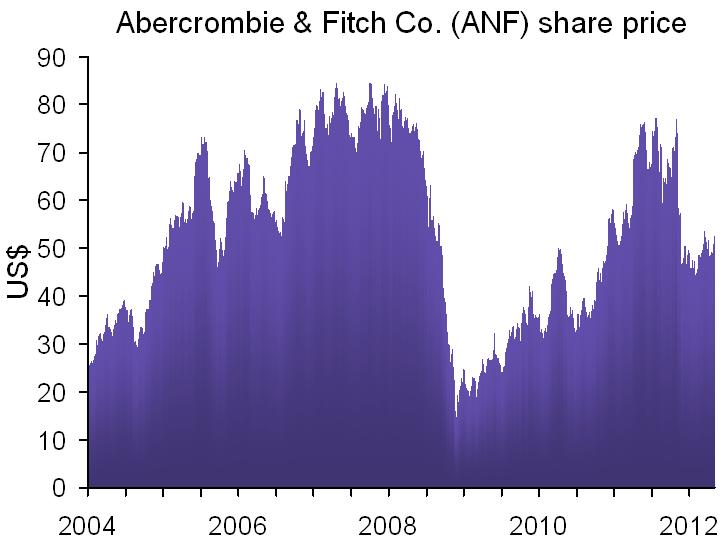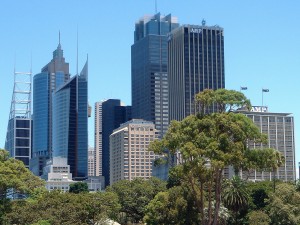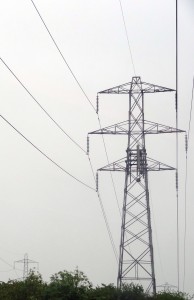 The trendy US fashion retailer Abercrombie & Fitch entered the UK in 2007 with the opening of a flagship store close to Savile Row in London. Located in the upmarket Mayfair area of London, Savile Row is famous for its traditional men’s tailors.
The trendy US fashion retailer Abercrombie & Fitch entered the UK in 2007 with the opening of a flagship store close to Savile Row in London. Located in the upmarket Mayfair area of London, Savile Row is famous for its traditional men’s tailors.
Recently Abercrombie & Fitch decided to go one step further by opening a childrenswear store directly on Savile Row. This move upset the local retailers and was met with protests.
This was just the latest in a history of controversy surrounding Abercrombie & Fitch which has included a product boycott and a lawsuit concerning employment issues. Should all this bad publicity be a concern for the company?
We expect tastes to be one of the key determinants of demand. If taste for a company’s product declines, its demand curve shifts to the left. This means it can sell less at any given price and consequently will have a knock-on effect on profits. Somewhat surprisingly, therefore, the PR expert, Mark Borkowski, quoted in the Guardian article above, suggests that all this adverse publicity may have in fact helped the company because:
“…the focus is on the brand. They’ve got a very keen identity of who they are, what they want, who they want to consume their products, and they’ve stuck to it.”
It is also clear that the company is very aware of the importance of protecting its brand – even going as far as paying television actors NOT to wear their clothes! Abercrombie & Fitch has also been reluctant to cut its prices during the current recession, perhaps because of a fear of harming its brand.
Abercrombie & Fitch with its ‘crappy clothes’ threatens staid Savile Row Observer, Euan Ferguson (11/03/12)
Savile Row cannot live in the past Guardian, Charlie Porter (24/04/12)
Sorry chaps, Abercrombie & Fitch simply doesn’t fit Savile Row Guardian, Gustav Temple (24/04/12)
Savile unrest … the tailors who want to stop Abercrombie & Fitch London Evening Standard, Josh Sims (27/04/12)
Questions
- What are the distinctive features of the Abercrombie & Fitch brand?
- What are the key features of competition in this industry?
- Why might Abercrombie & Fitch be keen to open up a store on Savile Row?
- Why might the local tailors object to Abercrombie & Fitch opening a store nearby?
- Why do you think negative publicity appears to have little effect on Abercrombie & Fitch?
- Why do you think television coverage could harm the Abercrombie & Fitch brand?
 Oligopoly: it’s a complex market structure and although closer to the monopoly end of the ‘Market Structure Spectrum’, it can still be a highly competitive market. The characteristics are well-documented and key to the degree of competition within any oligopoly is the number of competitors and extent to which there are barriers to entry.
Oligopoly: it’s a complex market structure and although closer to the monopoly end of the ‘Market Structure Spectrum’, it can still be a highly competitive market. The characteristics are well-documented and key to the degree of competition within any oligopoly is the number of competitors and extent to which there are barriers to entry.
The greater the barriers and the fewer the competitors the greater the power the established firms have. This can then spell trouble for pricing and hence for consumers. The following articles are just some examples of the oligopolies that exist around the world and some of the benefits and problems that accompany them.
Articles
Oligopoly of PSU oil cos reason for high ATF prices The Indian Express, Smita Aggarwal (30/4/12)
Group energy buying hits the UK headlines Spend Matters UK/Europe(18/1/11)
German cartel office probes petrol companies on pricing Fox Business (4/4/12)
Gov’t unveils steps to lower fuel prices Yonhap News (19/4/12)
How big banks threaten our economy Wall Street Journal, Warren Stephens (29/4/12)
UK Governance: Call for Whitehall to simplify the landscape for SME suppliers to win more government contracts The Information Daily (26/4/12)
Other blogs
Pumping up the price: fuel cartels in Germany April 2012
Energy profit margins up by over 700% October 2011
Every basket helps October 2011
The art of oligopoly December 2010
Questions
- What are the assumptions of an oligopolistic market structure?
- Consider (a) the energy sector and (b) the banking sector. To what extent does each market conform with the assumptions of an oligopoly?
- In the ‘Spend Matters’ article, a group of people in a Lincolnshire village formed a local buying consortium to negotiate deals for heating oil. What could we refer to this as?
- To what extent is an oligopoly in the public interest?
- Explain how barriers to entry in oligopolies affect the competitiveness and efficiency of a market.
- Illustrate how an oligopolistic market structure can fix prices and hence exploit consumers.
- How have the actions of the big oil companies in both the UK and Germany been against independent retailers and the consumer interest?
- What action can governments take to break up oligopolies? Will it always be effective?
 Is Google’s Android catching up with Apple’s iOS in the market for apps? With Android tablets and smartphones taking an ever larger proportion of the market, you would expect so. In the third quarter of 2011, 53% of smartphone shipments used Google’s Android system, compared with only 15% with iOS.
Is Google’s Android catching up with Apple’s iOS in the market for apps? With Android tablets and smartphones taking an ever larger proportion of the market, you would expect so. In the third quarter of 2011, 53% of smartphone shipments used Google’s Android system, compared with only 15% with iOS.
However, Apple is still ahead of Google in the share of apps downloads. To date, there have been 18 billion downloads from the iOS App Store for iPhone, iPad and iPod Touchs compared with 10 billion downloads of Android apps. But Android downloads are growing faster and are set to overtake those of iOS apps in the coming months. This should be boosted with the new Ice Cream Sandwich Android operating system.
But what about revenues earned from downloads? Here the picture is very different. Android Marketplace has earned around $330 million gross revenue for paid apps. Apple’s App Store, by contrast, has earned over 15 times as much: nearly $5000 million. The reason is that 99% of Android apps are free; the figure for App Store apps is 86%. But why is this so and how can Android earn revenues from its apps? And how can app developers earn revenues from the Android market? The following articles look at the economics of apps.
Android Vs. iPhone: The Economics Of Apps Financial Edge, Manish Sahajwani (6/1/12)
Google has an Amazon problem MSN Money, Jim J. Jubak (25/1/12)
Android and the economics of apps BBC News, Rory Cellan-Jones (7/12/11)
Apple Getting Best Of The Android Vs. iPhone Economics Forbes, Manish Sahajwani (6/1/12)
Fragmentation Is Not The End of Android cek.log, Charlie Kindel (14/1/12)
Questions
- Why are most Android apps free to download?
- What is the business model for (a) developing and (b) offering Android apps?
- How can money be made from free apps?
- What are the long-term strengths and weaknesses in Apple’s apps business model?
- Assess Amazon’s business model for apps for Kindle users.
 In an earlier blog Energy profits margins up by over 700% we analysed the increasing pressure on many households as they saw their energy bills increase in price year on year. This helped the big six energy companies achieve a 700% rise in their profits.
In an earlier blog Energy profits margins up by over 700% we analysed the increasing pressure on many households as they saw their energy bills increase in price year on year. This helped the big six energy companies achieve a 700% rise in their profits.
However, it also sparked interest by the regulator Ofgem, which was looking to ensure that consumers found it easier to make price comparisons and create a more competitive market. One issue that Ofgem were looking into was how to make the energy sector more open to competition, given that the big six companies own the power stations and hence this acts as a barrier to the entry of new firms.
The latest announcements from some of the big energy companies will therefore come as a pleasant turn of events for Ofgem. On Wednesday January 11th 2012, EDF announced that it would be cutting its energy prices by 5% from 7th February in response to a fall in wholesale costs. Only a day later, Npower announced its plans to cut its tariffs by 5% from 1st February. British Gas cut its prices by 5% with immediate effect and SSE will reduce its gas prices by 4.5% from March 26th.
Is this a sign that the market is becoming more competitive thanks to Ofgem or is there another explanation? For the past 2 winters, temperatures have been consistently below freezing and hence demand for gas/electricity was at an all time high, speaking concerns of gas shortages. However, with the mild winter we are currently experiencing (I hope I haven’t jinxed it!) demand for heating etc has been significantly lower, which has reduced wholesale costs and the big six companies have begun to pass these savings on to their customers. Yet, despite this seemingly good news, are they being as ‘kind’ as we think? Most of the companies are cutting their prices by about 5%, yet wholesale prices fell by significantly more than that. Furthermore, over the past few years, customers have seen their tariffs increase significantly – by a lot more than 5%. To some extent, this confirms the criticism levelled at the energy sector – when costs rise, they are quick to pass on the full costs to their customers. But, when costs fall, they are slow to pass on only a fraction of their cost savings. The following articles consider this issue.
Npower will cut gas prices by 5% BBC News (13/1/12)
EDF cuts gas price by 5% Reuters, Karolin Schaps and Henning Gloystein (11/1/12)
British Gas readies push to promote price cut MarketingWeek, Lara O’Reilly (13/1/12)
British Gas cuts prices by 5% Independent (13/1/12)
Energy suppliers do battle in the war of modest price cuts The Telegraph, Emily Godsen (13/1/12)
British Gas and SSE follow EDF Energy price cut Financial Times, Guy Chazan and Sylvia Pfeifer (11/1/12)
British Gas cuts electricity prices, but keeps gas on hold Guardian, Hillary Osborne (12/1/12)
British gas and SSE announce price cuts (including video) BBC News (12/1/12)
More power firms cut energy tariffs The Press Association (12/1/12)
Questions
- In which market structure would you place the energy sector? Explain your answer.
- What is the role of Ofgem? What powers does it (and the other regulators have)?
- Using a demand and supply diagram to help you, explain why wholesale costs have fallen.
- Why have the energy companies only passed on about 5% of cost savings to their customers, despite falls in wholesale costs of significantly more than that?
- Do you think price wars are likely to break out in this sector? Are they in the interests of consumers?
- Why did energy prices increase so quickly last year and the year before? Use a diagram to help you.
In many parts of the UK, bus services are run by a single operator. In other parts, it is little different, with the main operator facing competition on only a very limited number of routes. Over the whole of England, Scotland and Wales there are 1245 bus operators, but the ‘big five’ (Arriva, FirstGroup, Go-Ahead, National Express and Stagecoach) carry some 70% of passengers. Generally these five companies do not compete with each other, but, instead, operate as monopolies, or near monopolies, in their own specific areas. On average, the largest operator in an urban area runs 69% of local bus services.
Given this lack of competition and potential abuse of monopoly power, the Office of Fair Trading referred local bus services in Great Briatin (excluding London) to the Competition Commission (CC) in January 2010. The CC has just published its final report. Paragraph 5 of the summary to the report states:
We concluded that there were four features of local bus markets which mean that effective head-to-head competition is uncommon and which limit the effectiveness of potential competition and new entry. These features are the existence of: high levels of concentration; barriers to entry and expansion; customer conduct in deciding which bus to catch; and operator conduct by which operators avoid competing with other operators in ‘Core Territories’ (certain parts of an operator’s network which it regards as its ‘own’ territory) leading to geographic market segregation.
And paragraph 8 states:
We decided on a package of remedies with three main elements to address the AECs [adverse effects on competition] that we found. First, the remedies include market-opening measures to reduce barriers to entry and expansion, thereby reducing market concentration and providing an environment in which competition is likely to be sustained. By reducing barriers to entry and expansion, we also expect it to become harder for operators to sustain a coordinated outcome. Second, the remedies include measures to promote competition in relation to the tendering of contracts for supported services. Third, we made recommendations about the wider policy and regulatory environment, including emphasizing compliance with and effective enforcement of competition law.
The following articles look at the findings of the report and at the potential for improving the service to passengers, in terms of quality, frequency and price.
Articles
Competition regulator outlines bus market shake-up The Telegraph (20/12/11)
Bus market not competitive, Competition Commission says BBC News (20/12/11)
Passengers ‘need more bus rivalry’ Press Association (20/12/11)
Competition Commission publications
CC sets out Future Destination for Bus Market Competition Commission News Release (20/12/11)
Bus Market Inquiry: Final Report, Case Studies and Appendices Competition Commission (20/12/11)
Local Bus Services: Accompanying Documents Competition Commission (20/12/11)
Questions
- What are the barriers to entry in the market for local bus services?
- In what circumstances are local bus services a natural monopoly? Is this generally the case?
- In a non-regulated bus market, how could established operators use predatory pricing to drive out new entrants?
- How may offering reductions for return tickets reduce competition on routes where there is a large operator and one or more smaller ones?
- What practices can established large operators use to drive out smaller competitors?
- Go through the four reasons given by the CC why head-to-head competition in local bus markets is uncommon and in each case consider what remedies could be adopted by the regulator or by local authorities.
- Which of the remedies proposed by the CC involve encouraging more competition and which involve tighter regulation?
 The trendy US fashion retailer Abercrombie & Fitch entered the UK in 2007 with the opening of a flagship store close to Savile Row in London. Located in the upmarket Mayfair area of London, Savile Row is famous for its traditional men’s tailors.
The trendy US fashion retailer Abercrombie & Fitch entered the UK in 2007 with the opening of a flagship store close to Savile Row in London. Located in the upmarket Mayfair area of London, Savile Row is famous for its traditional men’s tailors.

